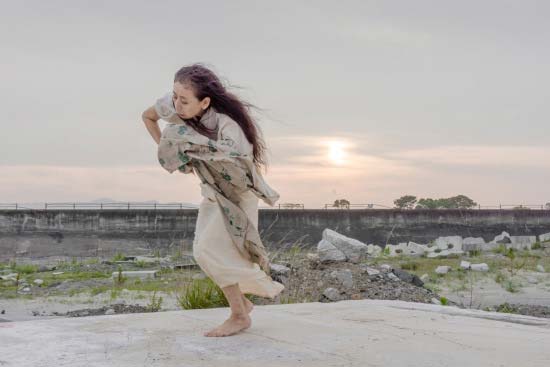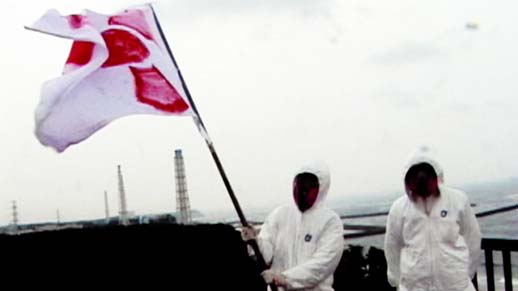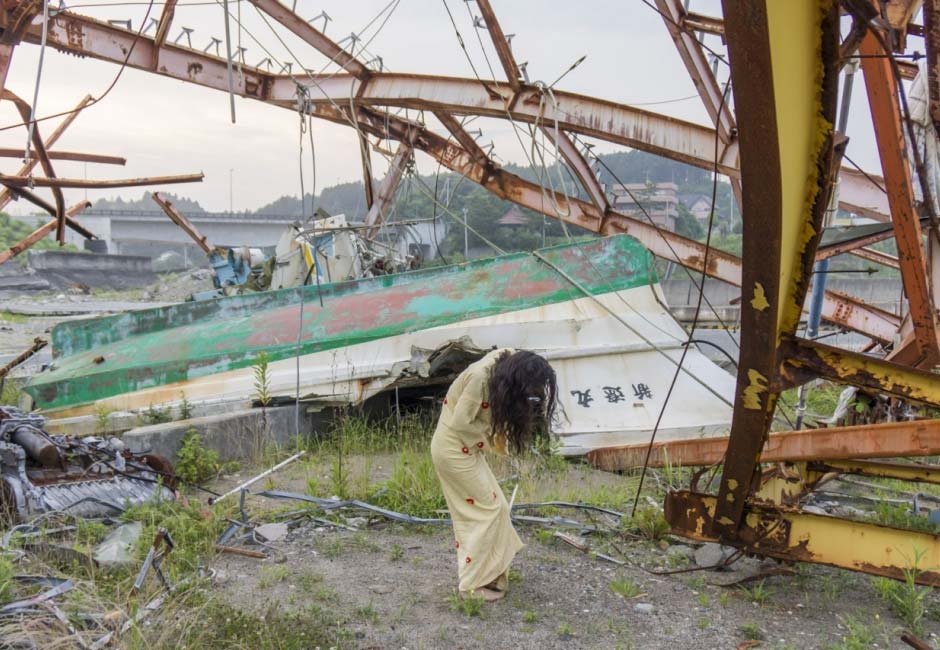“The French phrase faire le deuil, to make your grief, is accurate, I think, in its description of grief as a work you must do, rather than a time you submit to, waiting for it to end or pass.” So writes Rebecca Reilly towards the end of her beautiful memoir Repetition. You must make your grief, she insists. What brings things and people together is the work of grief.
This attitude of grief work pervades the art of several artists who traveled to Fukushima to bear witness to the ongoing nuclear crisis; entering an area still deemed too radioactive for human habitation.

Eiko Otake in Fukushima, Tomioka, 22 July 2014
Photograph by William Johnston
A Body in Fukushima (2014) is a touring exhibition of photographs by William Johnston featuring sexagenarian dancer Eiko Otake performing in deserted train stations and neighborhoods in Fukushima. The photos, elegantly composed but also unsettling, show Eiko as messenger ghost, almost feral with feeling, broken yet steadfast, wandering the ruins. (“As we got closer and closer to the reactor site, I got sadder and sadder,” she writes in her artist statement, “I wailed and lamented not only for the people, particularly children, who were affected by the radiation in addition to the natural disaster but also for the naked earth and sea that were irradiated, contaminated, and stained.”) Eiko uses her body as a spectral memorial, to commemorate the meltdown’s human fallout. (“I danced so as not to forget… I thought of the generations of people who used to live there. Now desolate, only time and wind continue to move.”)

Chim↑Pom members in front of Fukushima Daiichi nuclear plant
Still from REAL TIMES, April 2011
The six-member artists’ collective Chim↑Pom drew international attention less than a month after the reactor exploded in March 2011, when they filmed themselves in Hazmat suits as they breached the barricades around Fukushima Daiichi. There, within a few hundred yards of the stricken and smoldering reactors, they unfurled a white banner, spray-painted it with a red circle to represent the Japanese national flag, and then added three demarcations around the circle to transform it into the universal symbol for nuclear radiation before hoisting it on a flag pole. For another work, Chim↑Pom gathered flowers and plants that were growing in the “no go zone” and decontaminated them, measured them with a dosimeter, and brought them back to Tokyo where they created an elaborate and copious flower arrangement. The decorous art of ikebana took a swerve as the metronomic click, click, click of a Geiger counter recorded the radioactivity.
You make your grief, these artists propose, with a palette of stealthiness, slowness, accusation, remorse, mournfulness, pugilism, risk, sheer folly.
You do this to express sorrow and outrage that, once again on Japanese soil, a new generation of hibakusha has been born. You make your grief to recall the bowing to authority that paved the way for nuclear power to be pushed forward and rebranded ‘for peaceful purposes’ after Hiroshima and Nagasaki. And because it is difficult to fathom that a country as seismically exposed as Japan (a country that experiences 1500 seismic events every year) could even consider building power plants on its coastlines. You make your grief to come to grips with Japan’s imperialist history and the perils of patriotic compliance, to query the actions of Japan’s government and electric companies (that are lobbying to restart the reactors), to remember the uneven social effects of the nuclear disaster and the 130,000 nuclear exiles who still cannot return home.
You make your grief because you still do not know all the effects of chronic low radiation exposure. Do radioactive particles survive for thirty years, or seven million?
You do not know the wider long-term ecological impact of the still-leaking plant. The wake of this disaster is not ordered. It is more like a great pacific gyre, churning things up you thought you had forgotten or overcome. Unexpected things surface—memories but also emotions, moods, cancers, reverberations.

Eiko Otake, Eiko in Fukushima, Tomioka, 22 July 2014, No. 1104
Photo by William Johnston
You make your grief as you make your art. To hold a space. To put yourself on the line. But, mostly, to bring things and people together.